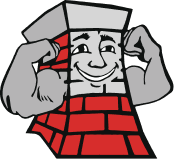What is Creosote and Should I be Concerned About It?
 Everyone who burns fires in their fireplaces or wood stoves ends up with a creosote issue, which is a potential hazard. When wood burns, combustion byproducts are produced and expelled through the chimney. These byproducts include gases, smoke, unburned wood particles, water vapor, tar fog, hydrocarbon, and various minerals. As these substances exit through the chimney, which is cooler, condensation occurs. Condensation of wood-burning byproducts results in highly flammable creosote on the walls of your chimney liner. Creosote is mostly tar and is brown or black in color. The substance takes several forms because it has three distinct stages, all of which are dangerous because they can cause hazardous chimney fires.
Everyone who burns fires in their fireplaces or wood stoves ends up with a creosote issue, which is a potential hazard. When wood burns, combustion byproducts are produced and expelled through the chimney. These byproducts include gases, smoke, unburned wood particles, water vapor, tar fog, hydrocarbon, and various minerals. As these substances exit through the chimney, which is cooler, condensation occurs. Condensation of wood-burning byproducts results in highly flammable creosote on the walls of your chimney liner. Creosote is mostly tar and is brown or black in color. The substance takes several forms because it has three distinct stages, all of which are dangerous because they can cause hazardous chimney fires.
Creosote – Stage 1
First stage creosote is mostly ashy soot. This creosote is the easiest to remove because a chimney professional’s chimney brush can typically get the job done. This type of creosote is formed as a result of the combination of:
- Relatively good wood combustion and
- Relatively high temperatures in the chimney flue.
This scenario fits with a traditional open fireplace. The logs on the fire have plenty of air during the combustion process, and heat pours into the chimney. This is a description of the best chimney conditions, as related to creosote.
Creosote – Stage 2
In the second stage or degree of creosote, cleanup is not as easy as in the first. The combustion byproducts are in the form of shiny black flakes. A good description of how they look is to imagine hardened tar the size of corn flakes. Stage two creosote doesn’t simply brush away, but it can be removed. Restricted air is the burning attribute that best describes how stage two creosote is formed. Burning logs in fireplaces and wood stoves with glass doors typically results in this form of flammable creosote.
Creosote – Stage 3
Creosote in the third stage is by far the most difficult to clean. In fact, there are times when the only way to make a chimney safe is to install a new chimney liner. Third degree creosote is extremely concentrated fuel and looks like tar running down inside the flue. As the creosote hardens, it is often repeatedly recoated.
The following are the conditions or combination of conditions which result in stage three creosote:
- The air controls on wood stoves are significantly turned down.
- A chimney is un-insulated or for some other reason cold.
- Unseasoned / green firewood is being used.
- The flue is too large / oversized for the appliance it is attached to.
- A sufficient amount of combustion air for the fire cannot be drawn because the house is too airtight.
Things can really get dangerous and complicated with third degree creosote when there is a chimney fire. The creosote partially boils and can leave a dried-out “sponge”, which can more easily be removed. But if the substance is not removed in this state, the sponges can fill up with more third degree creosote. Ultimately, more than 100 pounds of creosote could build up in the chimney, creating tremendous danger in the event of a chimney fire and causing deterioration of the chimney lining.
Primary Dangers of Creosote
 The two primary threats caused by creosote are chimney obstruction and chimney fires. If a chimney is obstructed, the result can be that toxic gases, including carbon monoxide, can enter the home. Everyone with a fireplace or stove should have a carbon monoxide detector in the home, since the gas is odorless, invisible, and tasteless.
The two primary threats caused by creosote are chimney obstruction and chimney fires. If a chimney is obstructed, the result can be that toxic gases, including carbon monoxide, can enter the home. Everyone with a fireplace or stove should have a carbon monoxide detector in the home, since the gas is odorless, invisible, and tasteless.
Chimney fires can damage a chimney lining and catch the home on fire or cause a rooftop fire. Stage three creosote is the most hazardous since the tar-like fuel is stuck like glue to the chimney lining, which feeds the fire continuously.
Call our chimney experts if you need an annual chimney inspection or cleaning or if you are unsure how much creosote is in your flue.


